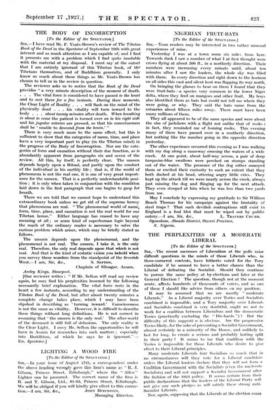THE BODY OF INCORRETPTION
[To the Editor of the SPECTATOR.] Snt,—I have read Mr. F. Yeats-Brown's review of The Tibetan Book of the Dead in the Spectator of September 10th with great interest and as much attention as I am capable of, and I find it presents me with a problem which I find quite insoluble with the material at my disposal. I must say at the outset that I am entirely ignorant of this Tibetan book, of the Tibetans themselves, and of Buddhism generally. I only know so much about these things as Mr. Yeats-Brown has chosen to tell us in the review in question.
The reviewer asks us to notice that the Book of the Dead provides "a very minute description of the moment of death. . . . The vital force is considered to have passed to the heart and to rest there for a few. instants. During these moments, the Clear Light of Reality . . . will flash on the mind of the physically dead . . . his vitality will turn inward to the • body . . . about twenty minutes after death. When breathing • is about to cease the patient is turned over on to his right side and his jugular arteries are pressed, so that his consciousness shall be 'unable to descend from the brain.'" There is very much more to the same effect, but this is sufficient to show that the categories of name, time, and place have a very important part to play (in the Tibetan mind) in the progress of the Body of Incorruption. Nor are the cate- gories of form and causation without their due function, as is abundantly apparent from paragraphs six and seven of the review. All this, by itself, is perfectly clear. The unseen depends largely upon a Ritual, and partly upon the conduct of the individual in his earthly life ; that is, if the world of phenomena is not the real one, it is one of very great import- ance for the unseen. That is a perfectly understandable posi- tion; it is only when taken in conjunction with the condition laid down in the first paragraph that one begins to gasp for breath.
There we are told that we cannot hope to understand this extraordinary book unless we get rid of the supreme heresy that phenomena are real. "The phenomenal world of name, form, time, place, and causation is not the real world for our Tibetan lamas." Either language has ceased to have any meaning at all ; or some kind of superhuman logic beyond the reach of the ordinary reader is necessary to solve the curious problem which arises, which may be briefly stated as follows.
The 'unseen depends upon the phenomenal, and the 'Phenomenal is not real. The unseen, I take it, is the only real. Therefore, the only real depends upon that which is not real. And that is the kind of ecstatic vision you behold when you survey these wonders from the standpoint of the feverish West.—I am, Sir, &c., S. SF.E-rorr,
[Our reviewer writes : "If Mr. Sefton will read my review again, he may find his perplexities lessened by the following necessarily brief explanation. The vital force rests in the heart a few instants, according to my understanding of the Tibetan Book of the Dead, but after about twenty minutes a complete change takes place, which I may have been slipshod in describing as 'turning inward.' Consciousness is notthe same as vitality. However, it is difficult to describe these things without long definitions. He is not correct in assuming that '.the unseen is the only real.' The after-world of the deceased is still full of delusions. The only reality is the Clear Light. I envy Mr. Sefton the opportunities he will have in Assam for researches into such matters ; especially into Buddhism, of which he says he is igriorant."-- En. Spectator.]














































 Previous page
Previous page